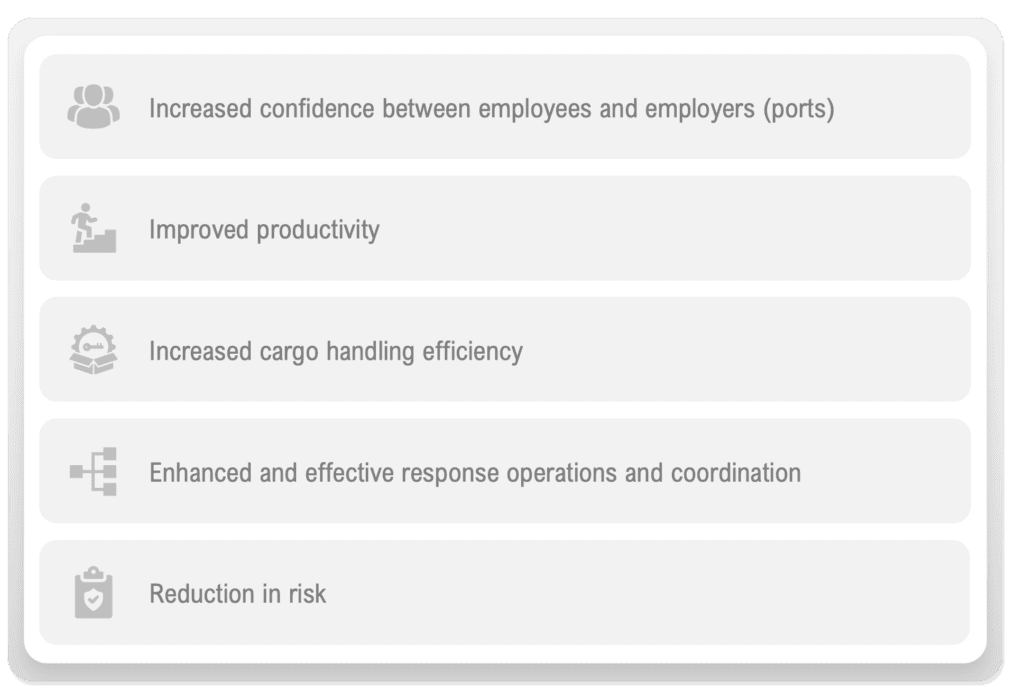This Transportation Considerations post covers the Fiscal Year (FY) 2023 port security funding opportunities and explores how they can be used to address current and emerging seaport threats.
The United States’ (US) seaports are infrastructure gateways for domestic and international trade, providing a critical link between national and global economies. Roughly 95 percent of international goods enter through US seaports. Moreover, cargo activities at US seaports account for 26 percent of the US economy – generating trillions of dollars in total economic activity and more than $300 billion in federal, state, and local taxes annually. While these crucial transportation hubs serve a vital economic purpose, they are also important for our nation’s security infrastructure, often providing the strategic deployment of materials and personnel during national emergencies.
Combatting Port Security Threats
With customer purchasing power at an all-time high through numerous digital purchasing platforms, the demand for foreign-made commodities continues growing, and the seaport and maritime industries are under pressure to keep up. To maintain critical supply chains and customer expectations, these industries are expanding and accelerating seaborne transportation operations. It is predicted that by 2050, seaports are expected to grow up to fourfold. As this industry continues to expand, the opportunity for potential threats increases as well.
Cyber Threats
- Operational Technology Disruptions: Seaports largely rely on Operational Technology (OT) systems (e.g., digital cranes) to perform at the scale and speed they need to meet consumer demand. Although OTs operate optimally, they pose critical cybersecurity threats by being connected to a single shared network. Cyber hackers have various methods to breach a single network and compromise dozens of OT systems, which can disrupt supply chain operations.
- Positioning, Navigation, and Timing (PNT) Interferences: PNT systems largely rely upon interfaces that create areas of vulnerability due to being online. Disruption to these online systems, whether by bad actors, human error, or equipment failure, poses potential risks such as blocking key transit routes, collisions, vessel damage, loss of life, release of hazardous material, and more.
- Facility Data Breaching: Online file storage is practiced at seaport facilities to organize client, cargo, and sensitive information. If bad actors choose to attack these online systems, it could aid their efforts to gain physical access to port facilities, steal cargo, and/or smuggle contraband.
Physical Threats
- Terrorism: Due to their location in highly populated areas and often proximity to natural gas terminals, seaports can be tempting targets for terrorism. Physical attacks at and around seaports can lead to fatalities as well as, depending on the scale, impact the US economy due to its heavy reliance on foreign trade.
- Cargo and Container Smuggling: Every year, 11 million cargo containers of foreign merchandise arrive at US seaports. Terrorists and other bad actors can use these congested trade areas to smuggle in black-market items that can be used to ignite attacks further in the mainland.
FY 2023 PORT INFRASTRUCTURE DEVELOPMENT PROGRAM (PIDP) FUNDING
To help mitigate these risks, the federal government continues to make significant investments in our nation’s port infrastructure and security. In 2022, the US Maritime Administration (MARAD) released a Notice of Funding Opportunity (NOFO) announcing that in 2023, FEMA would award select port authorities funding to improve the safety, efficiency, and reliability of the movement of goods through ports. Appropriated by the Bipartisan Infrastructure Law (BIL) and the FY 23 Consolidated Appropriations Act, this year’s PIDP awards encompass more than $662 million in funding for port infrastructure projects.
On November 3, 2023, MARAD announced recipients of FY 23 PIDP grant funding, awarding $653 million to help fund 41 port infrastructure projects across the US. Below are some of the improvements observed by seaports following the implementation of PIDP:

Additional Port Funding Opportunity
Alongside the PIDP funding opportunity, FEMA has allocated $100 million under the FY 23 Port Security Grant Program (PSGP), providing funding to state, local, territorial, and private sector partners to facilitate increased port-wide risk management and mitigate critical transportation infrastructure threats.
This year, PSGP funding has placed priority consideration on projects aimed at enhancing cybersecurity resilience and delivering the capabilities necessary to protect soft targets and crowded places. In addition, program funding can be used to address a range of enduring port security needs, including effective planning, training, and awareness campaigns, equipment and capital projects, and preparedness exercises.
Hagerty Can Help
Hagerty Consulting serves as a strategic partner for port authorities, offering holistic approaches to enhance their cyber and physical security efforts. Hagerty Consulting’s services encompass not only grant navigation but also crucial updates to and development of emergency plans, dynamic seminars and trainings, and exercise initiatives. By prioritizing awareness, Hagerty Consulting can encourage port authorities to be well-equipped to navigate the complexities of current and emerging security challenges, fortify their defenses, and safeguard vital maritime assets.
Sam Currie leads Hagerty’s Transportation sector within the Preparedness Division. In this role, he has supported the design, development, and execution of over 75 workshops, trainings, and exercises, both discussion-based and operational. Sam has supported and conducted multiple airport triennial full-scale exercises as well as rail tabletop exercises and drills. Additionally, Sam has extensive experience supporting active threat programs, including the development of response plans, discipline-specific operational guides, and numerous exercises related to integrated response, special operations, and family reunification/ assistance centers.
Jim McIntosh is a Senior Managing Associate who supports Hagerty’s Transportation sector. Jim brings twenty-four years of industry experience, having served as a first responder and emergency manager for both county and transit agencies before joining Hagerty’s team. He has also served as a consultant supporting local, state, federal, and private sector clients with emergency preparedness planning, training, and exercise needs.
Avery DeLong is an emergency management associate at Hagerty Consulting with experience assisting local, state, and federal partners in meeting their emergency preparedness, response, and recovery needs. In her role, she has had the opportunity to support a variety of clients, including transportation, active threat, energy, and cybersecurity projects.